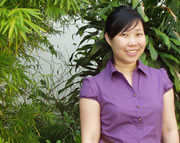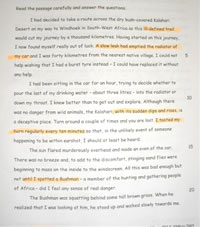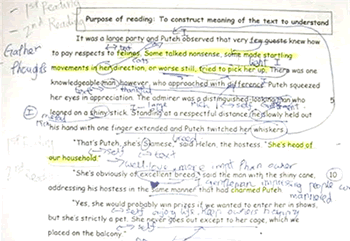Why Singapore’s English Teachers Should Embrace Singlish, Not Fight It
Is it time for Singaporean educators to embrace Singlish as a legitimate learning tool? What the Research […]
Read More
What do you do when your students don’t understand what they’re reading? For Changkat Primary’s Suzanne Chia, it’s all about finding the right strategy.
 For most of us, understanding text seems to be all about two simple steps: read and read again.
For most of us, understanding text seems to be all about two simple steps: read and read again.
Whether it be a new science fiction novel, the annual tax form or the daily paper, we’ve become so used to reading and rereading that the idea of finding a “better” way to do so almost seems strange.
An action research study by Suzanne Chia proves that it isn’t strange at all.
Her research shows that developing proper thinking habits among Primary 5 students at Changkat Primary School can help them tackle text in a way that’s meaningful, efficient and productive.
By using skills such as questioning and thinking aloud, Suzanne’s research tells us that understanding is not simply a matter of repetitive reading.
Reading comprehension has always been a serious concern for Changkat Primary School. With 60% of students failing this portion of their exams, it was a problem that seemed frustratingly insurmountable. “I think my principal would agree that we do a lot of teaching but the results are not improving,” says Suzanne. “Teachers work harder and they still don’t improve then we work even harder and this whole vicious cycle continues.”
 For Suzanne, a major problem was that students didn’t understand what they were reading. What’s worse, teachers didn’t offer alternative ways for them as well. “We interviewed students on what they did to understand the text and all they said was ‘underline’ and ‘highlight’,” recalls Suzanne.
For Suzanne, a major problem was that students didn’t understand what they were reading. What’s worse, teachers didn’t offer alternative ways for them as well. “We interviewed students on what they did to understand the text and all they said was ‘underline’ and ‘highlight’,” recalls Suzanne.
“So basically, what happens in class is that the teacher says, ‘Let’s read this together then I will explain it to you.’ If they don’t understand, they just have to read it again and again and again.”
When chosen to participate in the Ministry of Education’s Research Activist Scheme, Suzanne seized the opportunity to do action research on improving her students’ reading comprehension.
She wanted to see whether students can become strategic readers through Habits of Mind. “A strategic reader knows his or her purpose of reading,” Suzanne explains, “They monitor, manage and modify their understanding. Basically, the reader is someone who strives to be an independent learner.”
With countless educational theories on literacy and reading, deciding on just one was a tough process. In the end, Suzanne chose an approach that she was both familiar with and passionate about: Costa’s Habits of Mind (HoM).
Suzanne encountered HoM 4 years ago at a conference on gifted education. Since then, she has been practising HoM in her classroom teaching. “I’m really passionate about HoM because I’ve seen the results in my students. Some things just naturally began to change. I deliberately use HOM terminologies in the classroom and create a favourable environment for the cultivating and application of HOM.”
Introduced by Arthur Costa and Bena Kallick, HoM is basically about teaching students to develop intelligent ways to deal with situations where the answers are unknown. It outlines 16 habits which students should have in order to face the uncertainties of the modern world. Some examples are: managing impulsivity, thinking flexibly, gathering data through all the senses, and creating, imagining and innovating.
When it comes to reading comprehension, Costa (2006) believes that HoM could help students read more strategically. The goal of strategic readers is reading for understanding. Therefore, reading is treated as problem solving – where one must use different strategies to “fix” the problem in order to manage their understanding. Suzanne’s research question focused on whether HoM can create strategic readers among students in Changkat Primary School.
Within 3 weeks, Suzanne taught a module of 8 lessons which covered HoM and reading strategies to 104 Primary 5 students. These students were then asked to practice these skills in two reading tasks. Suzanne’s reading strategy comprised the following steps:
Students scan the narrative and get a basic idea of what it’s about. “This is so they can know the genre and what kind of text it is. They can also activate prior knowledge related to the text. Scanning is very important,” says Suzanne.
Students monitor their understanding by reading the text in detail. They apply “active reading symbols” which indicate how they interact with the text that they’re reading. For example, “?” means they have a question and “+” is used if they have learned a new word. Students are also encouraged to link contextual clues found in different parts of the text.

Here, students manage their understanding by using reading strategies to help them find the answers to the questions they noted during the first reading of the text. This is where they try to solve the problems that they encountered.
Although it’s too early to tell whether these reading strategies have had an effect on the student’s examination scores, Suzanne is satisfied to see a definite change in her students’ behaviour and attitude in reading. “We see a difference in the way they read now. They enjoy drawing lines to show linkages and using the symbols. It’s not just ‘dead’ reading anymore.”
Based on surveys, observations and teachers’ reflections, students were monitoring, managing and modifying their behaviour more frequently. They were more metacognitive as they were able to articulate the thinking habits and reading strategies that helped them understand the text.
A study of the active reading symbols used showed that they were asking more questions as well. This is a big step considering that these were the same students who only knew how to underline and highlight difficult words.
In a way, the HoM approach complemented the MOE campaign for teachers to teach less and learn more. “No point doing ten worksheets on the same lesson. Let’s deal with the problem and do more in-depth teaching,” says Suzanne.
Currently, other teachers at Changkat Primary have been encouraged to try HoM in their own classrooms. Suzanne herself has been busy refining her own use of HoM and using the results to win others over.
“When you do a HoM lesson, you have to think on your feet,” Suzanne says. “Teachers are not always comfortable with this because you have to ask the right questions and when the children give you a response, the leading question should be another thinking question.”
Still, there are signs of progress in her “baby steps” approach to infusing HoM in the curriculum. One of which is the case of an initially sceptical Chinese Language teacher who recently discovered that strategic reading with HoM can suit Chinese text as well, “She loves it,” beamed Suzanne, “It fits her teaching style very well and now she’s leading the Mother Tongue department in using it.”
Although her experience as a teacher-researcher has had its share of challenges, Suzanne is thankful for the opportunity to prove the benefits of HoM beyond personal observations and classroom anecdotes. “I was told to do research on something I was passionate about so that’s why I chose HoM. At first I didn’t want to but then I thought, ‘Yeah, I started this whole thing. It’s time I showed results in a more concrete way.'”